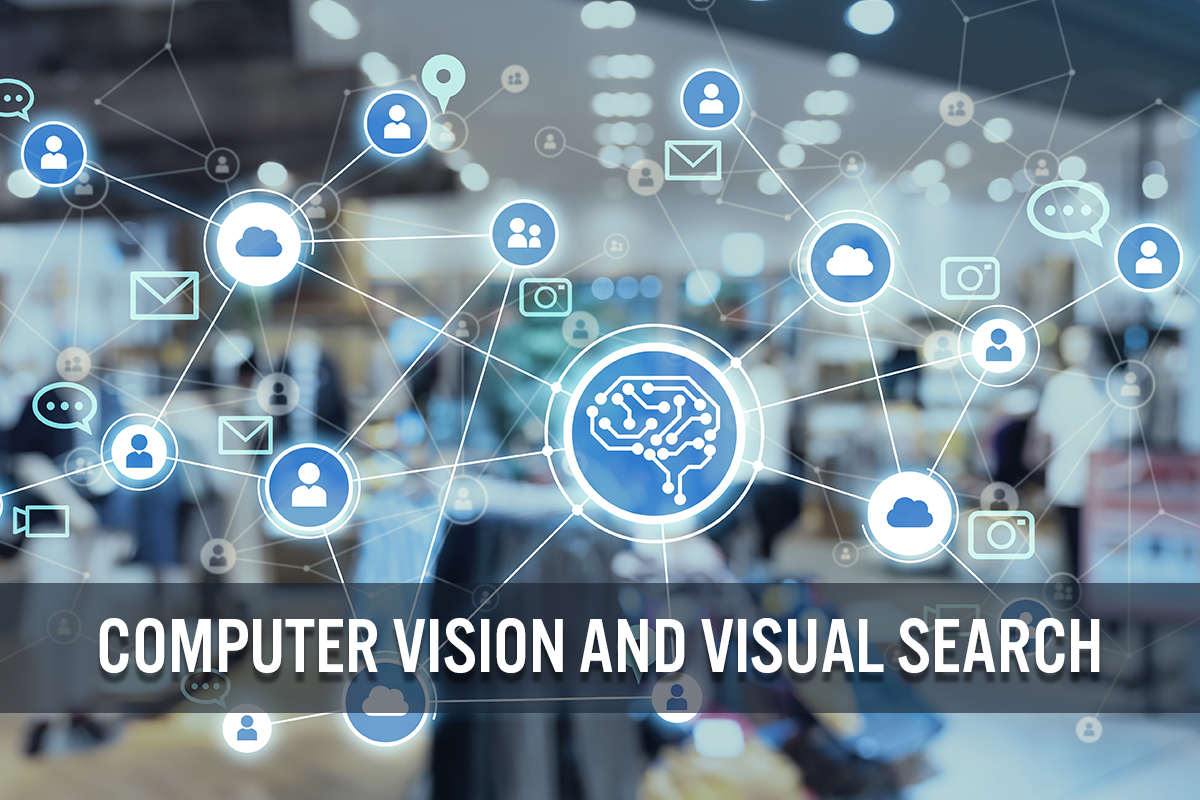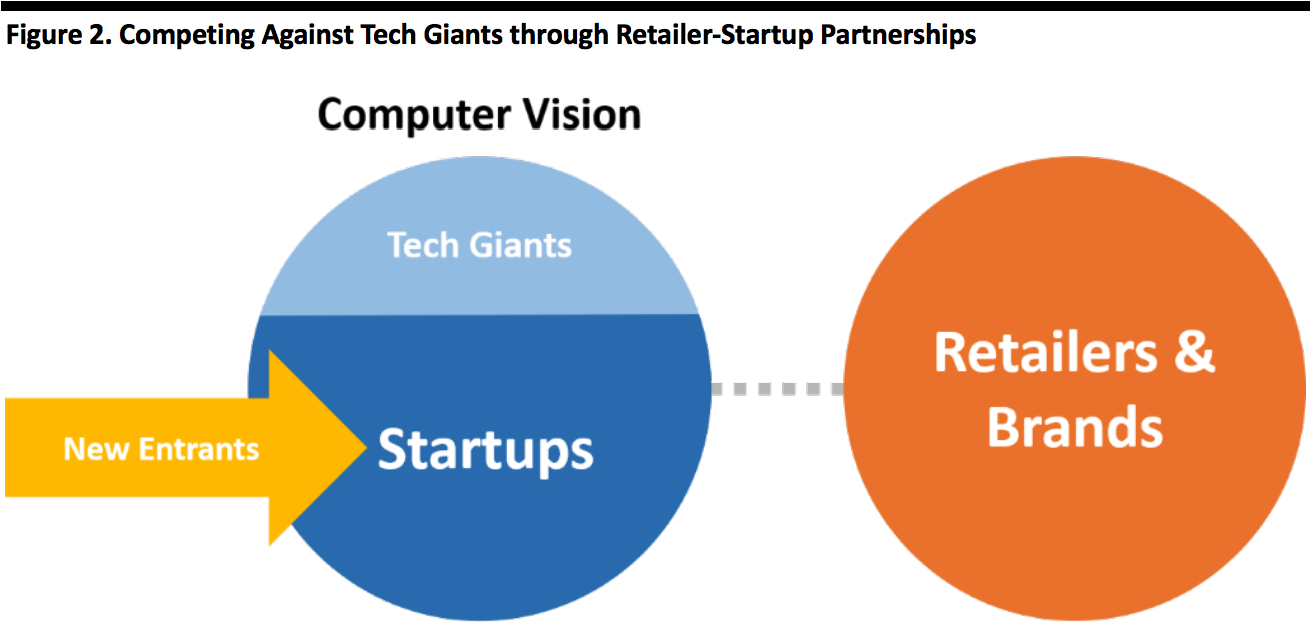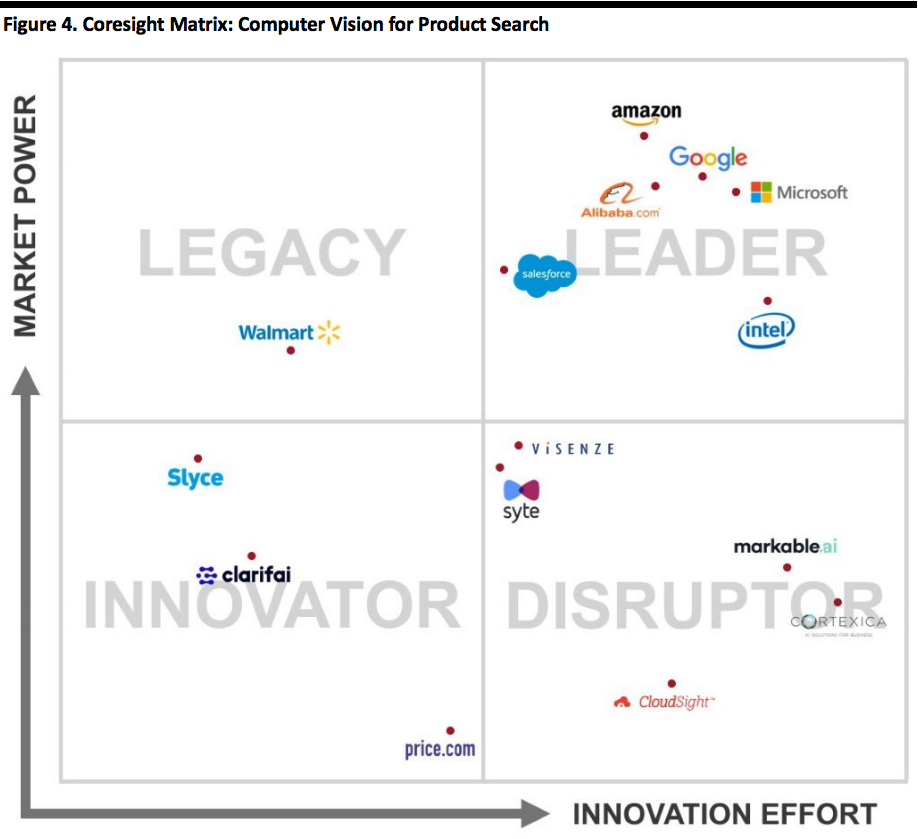
Nitheesh NH
The retail industry has seen the rapid adoption of computer vision over the last few years. This transformative technology is enabling greater operational efficiency for retailers and is providing shoppers with new ways to explore products and interact with retailers and brands. Furthermore, improved computation power has led to major strides in the development of deep-learning applications such as visual search technology, which enhances retailers’ engagement with consumers.
Walmart Leads Computer Vision Research and Development among Legacy Retailers
Most R&D activity focusing on retail applications of computer vision is undertaken by technology giants that are already involved in significant retail operations (see Figure 1). While companies including Microsoft act primarily as technology providers, others, such as Amazon, apply the technology directly to their own retail operations. This poses a real competitive threat to legacy retailers, which need to react quickly in order to remain competitive.
[caption id="attachment_101878" align="aligncenter" width="700"] Computer vision patent applications and grants by selected major retail-related companies in the 12-month period ended December 16, 2019
Computer vision patent applications and grants by selected major retail-related companies in the 12-month period ended December 16, 2019
Source: Grata Data[/caption] Walmart is one legacy retailer that is showing significant computer vision R&D activity. The company is using computer vision to monitor in-store inventory levels in real time, enabling store associates to timely restock shelves and avoid stockouts. [caption id="attachment_101879" align="aligncenter" width="700"] Source: Walmart[/caption]
Walmart is also deploying computer vision for theft prevention in more than 1,000 stores, Business Insider reported in June 2019. The Missed Scan Detection program uses cameras to monitor cashier-operated and self-checkouts registers for scanning failures, in order to reduce shrinkage and deter theft.
Collaboration with Emerging Technology Companies Is a Key Adoption Strategy
With the exception of a few companies such as Walmart, developing proprietary computer vision platforms is often out of reach or simply not a strategic priority for brands and retailers. This is because they usually do not have the required internal resources to undertake extensive computer vision-focused R&D. As such, collaborating with emerging technology providers and startups is often the best way for legacy retailers and brands to acquire the capabilities needed to adopt this technology.
Source: Walmart[/caption]
Walmart is also deploying computer vision for theft prevention in more than 1,000 stores, Business Insider reported in June 2019. The Missed Scan Detection program uses cameras to monitor cashier-operated and self-checkouts registers for scanning failures, in order to reduce shrinkage and deter theft.
Collaboration with Emerging Technology Companies Is a Key Adoption Strategy
With the exception of a few companies such as Walmart, developing proprietary computer vision platforms is often out of reach or simply not a strategic priority for brands and retailers. This is because they usually do not have the required internal resources to undertake extensive computer vision-focused R&D. As such, collaborating with emerging technology providers and startups is often the best way for legacy retailers and brands to acquire the capabilities needed to adopt this technology.
 Source: Company reports/Coresight Research[/caption]
Further Expansion of Visual Search Is Expected in 2020
Visual search is an application of computer vision that represents a breakthrough in the way that consumers interact with retailers, by offering a straightforward and intuitive way to shop.
The growing use of image- and video-intense social media apps—including Instagram and TikTok—is contributing to the adoption of visual search. For example, a shopper can scan a product through the Instagram app to be directed to the retailer’s Instagram account.
The transformation of the shopping experience through visual search is influencing consumer purchasing behaviors. A 2019 survey of over 1,000 US consumers by visual search provider ViSenze showed a number of key findings:
Source: Company reports/Coresight Research[/caption]
Further Expansion of Visual Search Is Expected in 2020
Visual search is an application of computer vision that represents a breakthrough in the way that consumers interact with retailers, by offering a straightforward and intuitive way to shop.
The growing use of image- and video-intense social media apps—including Instagram and TikTok—is contributing to the adoption of visual search. For example, a shopper can scan a product through the Instagram app to be directed to the retailer’s Instagram account.
The transformation of the shopping experience through visual search is influencing consumer purchasing behaviors. A 2019 survey of over 1,000 US consumers by visual search provider ViSenze showed a number of key findings:
 Source: Coresight Research[/caption]
Outlook
Moving forward, the expected commercial introduction of 5G connectivity should unleash further use cases for data-intense technology in retail, such as visual search. This will be supported by the proliferation and enhanced functionality of consumers’ smartphones.
We expect greater visual interaction to occur in and outside the physical store in the near future. Furthermore, advanced interaction opportunities between retailers and consumers will be made possible through the expansion of visual search applications and the integration of other visually intense, video game-like technologies and augmented/mixed-reality software.
Source: Coresight Research[/caption]
Outlook
Moving forward, the expected commercial introduction of 5G connectivity should unleash further use cases for data-intense technology in retail, such as visual search. This will be supported by the proliferation and enhanced functionality of consumers’ smartphones.
We expect greater visual interaction to occur in and outside the physical store in the near future. Furthermore, advanced interaction opportunities between retailers and consumers will be made possible through the expansion of visual search applications and the integration of other visually intense, video game-like technologies and augmented/mixed-reality software.
 Computer vision patent applications and grants by selected major retail-related companies in the 12-month period ended December 16, 2019
Computer vision patent applications and grants by selected major retail-related companies in the 12-month period ended December 16, 2019Source: Grata Data[/caption] Walmart is one legacy retailer that is showing significant computer vision R&D activity. The company is using computer vision to monitor in-store inventory levels in real time, enabling store associates to timely restock shelves and avoid stockouts. [caption id="attachment_101879" align="aligncenter" width="700"]
 Source: Walmart[/caption]
Walmart is also deploying computer vision for theft prevention in more than 1,000 stores, Business Insider reported in June 2019. The Missed Scan Detection program uses cameras to monitor cashier-operated and self-checkouts registers for scanning failures, in order to reduce shrinkage and deter theft.
Collaboration with Emerging Technology Companies Is a Key Adoption Strategy
With the exception of a few companies such as Walmart, developing proprietary computer vision platforms is often out of reach or simply not a strategic priority for brands and retailers. This is because they usually do not have the required internal resources to undertake extensive computer vision-focused R&D. As such, collaborating with emerging technology providers and startups is often the best way for legacy retailers and brands to acquire the capabilities needed to adopt this technology.
Source: Walmart[/caption]
Walmart is also deploying computer vision for theft prevention in more than 1,000 stores, Business Insider reported in June 2019. The Missed Scan Detection program uses cameras to monitor cashier-operated and self-checkouts registers for scanning failures, in order to reduce shrinkage and deter theft.
Collaboration with Emerging Technology Companies Is a Key Adoption Strategy
With the exception of a few companies such as Walmart, developing proprietary computer vision platforms is often out of reach or simply not a strategic priority for brands and retailers. This is because they usually do not have the required internal resources to undertake extensive computer vision-focused R&D. As such, collaborating with emerging technology providers and startups is often the best way for legacy retailers and brands to acquire the capabilities needed to adopt this technology.
- Trax uses computer vision to help retailers to track stock on shelves and implement in-store execution strategies successfully.
- Scandit allows retailers to automate inventory-related routine tasks by leveraging computer vision and barcode scanning.
- Inokyo leverages artificial intelligence (AI) and computer vision to automate retailers’ interactions with shoppers in physical stores.
- Gather uses AI and drones to monitor stock levels in warehouses and distribution centers. The automated vehicles use computer vision to check and update inventory records.
- Sensei offers an AI and computer vision-powered system that automates retailers’ interactions with shoppers in physical stores.
 Source: Company reports/Coresight Research[/caption]
Further Expansion of Visual Search Is Expected in 2020
Visual search is an application of computer vision that represents a breakthrough in the way that consumers interact with retailers, by offering a straightforward and intuitive way to shop.
The growing use of image- and video-intense social media apps—including Instagram and TikTok—is contributing to the adoption of visual search. For example, a shopper can scan a product through the Instagram app to be directed to the retailer’s Instagram account.
The transformation of the shopping experience through visual search is influencing consumer purchasing behaviors. A 2019 survey of over 1,000 US consumers by visual search provider ViSenze showed a number of key findings:
Source: Company reports/Coresight Research[/caption]
Further Expansion of Visual Search Is Expected in 2020
Visual search is an application of computer vision that represents a breakthrough in the way that consumers interact with retailers, by offering a straightforward and intuitive way to shop.
The growing use of image- and video-intense social media apps—including Instagram and TikTok—is contributing to the adoption of visual search. For example, a shopper can scan a product through the Instagram app to be directed to the retailer’s Instagram account.
The transformation of the shopping experience through visual search is influencing consumer purchasing behaviors. A 2019 survey of over 1,000 US consumers by visual search provider ViSenze showed a number of key findings:
- Visual search facilitates product discovery for 73% of consumers.
- 40% of consumers said that finding products online or in-store is challenging.
- 64% of all product searches occur via mobile devices.
- 87% of consumers are more likely to buy an item if the product search is facilitated by visual search through their mobile devices.
- Fast-fashion retail brand Uniqlo collaborates with ViSenze to offer visual search to consumers. Through ViSenze’s technology, shoppers browsing in physical Uniqlo stores can take a photo of an item and then find it through the retailer’s app, eliminating the time-consuming process of opening a browser and searching for a product by typing its features.
- In May 2019, consumer electronics giant Samsung announced a partnership with visual search technology firm Syte.ai to develop a platform that enables consumers to use their phone cameras to scan products and shop for visually similar items.
 Source: Coresight Research[/caption]
Outlook
Moving forward, the expected commercial introduction of 5G connectivity should unleash further use cases for data-intense technology in retail, such as visual search. This will be supported by the proliferation and enhanced functionality of consumers’ smartphones.
We expect greater visual interaction to occur in and outside the physical store in the near future. Furthermore, advanced interaction opportunities between retailers and consumers will be made possible through the expansion of visual search applications and the integration of other visually intense, video game-like technologies and augmented/mixed-reality software.
Source: Coresight Research[/caption]
Outlook
Moving forward, the expected commercial introduction of 5G connectivity should unleash further use cases for data-intense technology in retail, such as visual search. This will be supported by the proliferation and enhanced functionality of consumers’ smartphones.
We expect greater visual interaction to occur in and outside the physical store in the near future. Furthermore, advanced interaction opportunities between retailers and consumers will be made possible through the expansion of visual search applications and the integration of other visually intense, video game-like technologies and augmented/mixed-reality software.